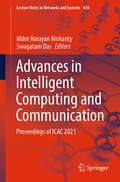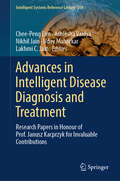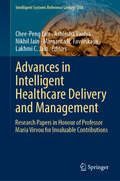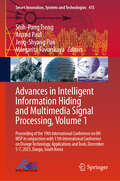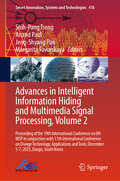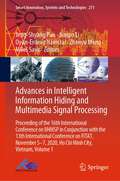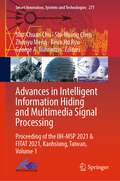- Table View
- List View
Advances in Intelligent Computing and Communication: Proceedings of ICAC 2021 (Lecture Notes in Networks and Systems #430)
by Swagatam Das Mihir Narayan MohantyThe book presents high-quality research papers presented at 4th International Conference on Intelligent Computing and Advances in Communication (ICAC 2021) organized by Siksha ‘O’ Anusandhan, Deemed to be University, Bhubaneswar, Odisha, India, in November 2021. This book brings out the new advances and research results in the fields of theoretical, experimental, and applied signal and image processing, soft computing, networking, and antenna research. Moreover, it provides a comprehensive and systematic reference on the range of alternative conversion processes and technologies.
Advances in Intelligent Computing: Proceedings Of The 49th Annual Convention Of The Computer Society Of India Csi (Studies In Computational Intelligence #687)
by Paramartha Dutta Jyotsna Kumar Mandal Somnath MukhopadhyayDiscusses computational intelligence and business analytics in computer science and engineering.<P> Encompasses the latest technological developments from an inter- and intra-disciplinary perspective.<P> Presents hybridization models for solving real-world problems.<P> This edited volume on computational intelligence algorithms-based applications includes work presented at the International Conference on Computational Intelligence, Communications, and Business Analytics (CICBA 2017). It provides the latest research findings on the significance of computational intelligence and related application areas. It also introduces various computation platforms involving evolutionary algorithms, fuzzy logic, swarm intelligence, artificial neural networks and several other tools for solving real-world problems. It also discusses various tools that are hybrids of more than one solution framework, highlighting the theoretical aspects as well as various real-world applications.
Advances in Intelligent Data Analysis XIV: 14th International Symposium, IDA 2015, Saint Etienne. France, October 22 -24, 2015. Proceedings (Lecture Notes in Computer Science #9385)
by Elisa Fromont Tijl De Bie Matthijs Van LeeuwenThis book constitutes the refereed conference proceedings of the 14th International Conference on Intelligent Data Analysis, which was held in October 2015 in Saint Étienne. France. The 29 revised full papers were carefully reviewed and selected from 65 submissions. The traditional focus of the IDA symposium series is on end-to-end intelligent support for data analysis. The symposium aims to provide a forum for inspiring research contributions that might be considered preliminary in other leading conferences and journals, but that have a potentially dramatic impact. To facilitate this, IDA 2015 will feature two tracks: a regular "Proceedings" track, as well as a "Horizon" track for early-stage research of potentially ground-breaking nature.
Advances in Intelligent Data Analysis XIX: 19th International Symposium on Intelligent Data Analysis, IDA 2021, Porto, Portugal, April 26–28, 2021, Proceedings (Lecture Notes in Computer Science #12695)
by João Gama Pedro Henriques Abreu Alberto Fernández Pedro Pereira RodriguesThis book constitutes the proceedings of the 19th International Symposium on Intelligent Data Analysis, IDA 2021, which was planned to take place in Porto, Portugal. Due to the COVID-19 pandemic the conference was held online during April 26-28, 2021.The 35 papers included in this book were carefully reviewed and selected from 113 submissions. The papers were organized in topical sections named: modeling with neural networks; modeling with statistical learning; modeling language and graphs; and modeling special data formats.
Advances in Intelligent Data Analysis XV: 15th International Symposium, IDA 2016, Stockholm, Sweden, October 13-15, 2016, Proceedings (Lecture Notes in Computer Science #9897)
by Henrik Boström Arno Knobbe Carlos Soares Panagiotis PapapetrouThis book constitutes the refereed conference proceedings of the 15th International Conference on Intelligent Data Analysis, which was held in October 2016 in Stockholm, Sweden. The 36 revised full papers presented were carefully reviewed and selected from 75 submissions. The traditional focus of the IDA symposium series is on end-to-end intelligent support for data analysis. The symposium aims to provide a forum for inspiring research contributions that might be considered preliminary in other leading conferences and journals, but that have a potentially dramatic impact.
Advances in Intelligent Data Analysis XVI: 16th International Symposium, IDA 2017, London, UK, October 26–28, 2017, Proceedings (Lecture Notes in Computer Science #10584)
by Niall Adams, Allan Tucker and David WestonThis book constitutes the conference proceedings of the 16th International Symposium on Intelligent Data Analysis, which was held in October 2017 in London, UK.The 28 full papers presented in this book were carefully reviewed and selected from 66 submissions. The traditional focus of the IDA symposium series is on end-to-end intelligent support for data analysis. IDA solicits papers on all aspects of intelligent data analysis, including papers on intelligent support for modelling and analyzing data from complex, dynamical systems.
Advances in Intelligent Data Analysis XVII: 17th International Symposium, IDA 2018, ’s-Hertogenbosch, The Netherlands, October 24–26, 2018, Proceedings (Lecture Notes in Computer Science #11191)
by Wouter Duivesteijn Arno Siebes Antti UkkonenThis book constitutes the conference proceedings of the 17th International Symposium on Intelligent Data Analysis, which was held in October 2018 in ‘s-Hertogenbosch, the Netherlands. The traditional focus of the IDA symposium series is on end-to-end intelligent support for data analysis. The 29 full papers presented in this book were carefully reviewed and selected from 65 submissions. The papers cover all aspects of intelligent data analysis, including papers on intelligent support for modeling and analyzing data from complex, dynamical systems.
Advances in Intelligent Data Analysis XVIII: 18th International Symposium on Intelligent Data Analysis, IDA 2020, Konstanz, Germany, April 27–29, 2020, Proceedings (Lecture Notes in Computer Science #12080)
by Michael R. Berthold Ad Feelders Georg KremplThis open access book constitutes the proceedings of the 18th International Conference on Intelligent Data Analysis, IDA 2020, held in Konstanz, Germany, in April 2020. The 45 full papers presented in this volume were carefully reviewed and selected from 114 submissions. Advancing Intelligent Data Analysis requires novel, potentially game-changing ideas. IDA’s mission is to promote ideas over performance: a solid motivation can be as convincing as exhaustive empirical evaluation.
Advances in Intelligent Data Analysis XX: 20th International Symposium on Intelligent Data Analysis, IDA 2022, Rennes, France, April 20–22, 2022, Proceedings (Lecture Notes in Computer Science #13205)
by Elisa Fromont Eyke Hüllermeier Tassadit BouadiThis book constitutes the proceedings of the 20th International Symposium on Intelligent Data Analysis, IDA 2022, which was held in Rennes, France, during April 20-22, 2022. The 31 papers included in this book were carefully reviewed and selected from 73 submissions. They deal with high quality, novel research in intelligent data analysis.
Advances in Intelligent Data Analysis XXI: 21st International Symposium on Intelligent Data Analysis, IDA 2023, Louvain-la-Neuve, Belgium, April 12–14, 2023, Proceedings (Lecture Notes in Computer Science #13876)
by Siegfried Nijssen Bruno Crémilleux Sibylle HessThis book constitutes the proceedings of the 21st International Symposium on Intelligent Data Analysis, IDA 2022, which was held in Louvain-la-Neuve, Belgium, during April 12-14, 2023. The 38 papers included in this book were carefully reviewed and selected from 91 submissions. IDA is an international symposium presenting advances in the intelligent analysis of data. Distinguishing characteristics of IDA are its focus on novel, inspiring ideas, its focus on research, and its relatively small scale.
Advances in Intelligent Data Analysis XXII: 22nd International Symposium on Intelligent Data Analysis, IDA 2024, Stockholm, Sweden, April 24–26, 2024, Proceedings, Part I (Lecture Notes in Computer Science #14641)
by Nico Piatkowski Panagiotis Papapetrou Ioanna MiliouThe two volume set LNCS 14641 and 14642 constitutes the proceedings of the 22nd International Symposium on Intelligent Data Analysis, IDA 2024, which was held in Stockholm, Sweden, during April 24-26, 2024. The 40 full and 3 short papers included in the proceedings were carefully reviewed and selected from 94 submissions. IDA is an international symposium presenting advances in the intelligent analysis of data. Distinguishing characteristics of IDA are its focus on novel, inspiring ideas, its focus on research, and its relatively small scale.
Advances in Intelligent Data Analysis XXII: 22nd International Symposium on Intelligent Data Analysis, IDA 2024, Stockholm, Sweden, April 24–26, 2024, Proceedings, Part II (Lecture Notes in Computer Science #14642)
by Nico Piatkowski Panagiotis Papapetrou Ioanna MiliouThe two volume set LNCS 14641 and 14642 constitutes the proceedings of the 22nd International Symposium on Intelligent Data Analysis, IDA 2024, which was held in Stockholm, Sweden, during April 24-26, 2024. The 40 full and 3 short papers included in the proceedings were carefully reviewed and selected from 94 submissions. IDA is an international symposium presenting advances in the intelligent analysis of data. Distinguishing characteristics of IDA are its focus on novel, inspiring ideas, its focus on research, and its relatively small scale.
Advances in Intelligent Data Analysis XXIII: 23rd International Symposium on Intelligent Data Analysis, IDA 2025, Konstanz, Germany, May 7–9, 2025, Proceedings (Lecture Notes in Computer Science #15669)
by Georg Krempl Ioanna Miliou Kai PuolamäkiThis volume constitutes the proceedings of the 23rd International Symposium on Intelligent Data Analysis, IDA 2025, which was held in Konstanz, Germany, during May 7–9, 2025. The 35 full papers included in the proceedings were carefully reviewed and selected from 91 submissions. They were organized in topical sections as follows: Applications of data science, foundations of data science; natural language processing; temporal and streaming data; and explainable and interpretable data science.
Advances in Intelligent Data Analysis and Applications: Proceeding of the Sixth Euro-China Conference on Intelligent Data Analysis and Applications, 15–18 October 2019, Arad, Romania (Smart Innovation, Systems and Technologies #253)
by Jeng-Shyang Pan Valentina Emilia Balas Chien-Ming ChenThis book constitutes the Proceeding of the Sixth International Conference on Intelligent Data Analysis and Applications, October 15–18, 2019, Arad, Romania. This edition is technically co-sponsored by “Aurel Vlaicu” University of Arad, Romania, Southwest Jiaotong University, Fujian University of Technology, Chang’an University, Shandong University of Science and Technology, Fujian Provincial Key Lab of Big Data Mining and Applications, and National Demonstration Center for Experimental Electronic Information and Electrical Technology Education (Fujian University of Technology), China, Romanian Academy, and General Association of Engineers in Romania - Arad Section. The book covers a range of topics: Machine Learning, Intelligent Control, Pattern Recognition, Computational Intelligence, Signal Analysis, Modeling and Visualization, Multimedia Sensing and Sensory Systems, Signal control, Imaging and Processing, Information System Security, Cryptography and Cryptanalysis, Databases and Data Mining, Information Hiding, Cloud Computing, Information Retrieval and Integration, Robotics, Control, Agents, Command, Control, Communication and Computers (C4), Swarming Technology, Sensor Technology, Smart cities.The book offers a timely, board snapshot of new development including trends and challenges that are yielding recent research directions in different areas of intelligent data analysis and applications. The book provides useful information to professors, researchers, and graduated students in area of intelligent data analysis and applications.
Advances in Intelligent Disease Diagnosis and Treatment: Research Papers in Honour of Prof. Janusz Kacprzyk for Invaluable Contributions (Intelligent Systems Reference Library #259)
by Lakhmi C. Jain Chee-Peng Lim Ashlesha Vaidya Nikhil Jain Uday MahorkarThe book delves into innovations in AI and related computing paradigms for disease detection and diagnosis. The collected chapters elucidate the use of a variety of AI and related methodologies to address specific medical challenges. From detecting pancreatic cancer, classifying micro-emboli in stroke diagnosis, to segmenting brain tumours from MRI data, and more, the culmination of these studies underscores the transformative impact AI and digital technologies can have on healthcare, emphasising their potential to enhance medical treatment and improve patient care.
Advances in Intelligent Healthcare Delivery and Management: Research Papers in Honour of Professor Maria Virvou for Invaluable Contributions (Intelligent Systems Reference Library #258)
by Lakhmi C. Jain Margarita N. Favorskaya Chee-Peng Lim Ashlesha Vaidya Nikhil JainThis book unveils the dynamic fusion of artificial intelligence (AI) and related innovations in healthcare delivery and management. The collected chapters delve into innovative and intelligent methods for improving healthcare services, from electronic health records management, robotics and AI in healthcare, to data-driven decision-making. Readers can discover how AI-based methodologies empower different facets of healthcare delivery and management, building a future where digital technologies are leveraged to enhance the quality and accessibility of healthcare services.
Advances in Intelligent Informatics, Smart Technology and Natural Language Processing: Selected Revised Papers From The Joint International Symposium On Artificial Intelligence And Natural Language Processing (isai-nlp 2017) (Advances in Intelligent Systems and Computing #807)
by Kiyota Hashimoto Thanaruk Theeramunkong Thepchai Supnithi Mahasak Ketcham Narit Hnoohom Rachada Kongkachandra Pokpong SongmuangThis book constitutes the refereed proceedings of the 13th Joint International Symposium on Artificial Intelligence and Natural Language Processing, iSAI-NLP2017, held in Prachuap Khiri Khan, Thailand, in August 2017, and the 10th International Conference on Knowledge, Information and Creativity Support Systems, KICSS2015, held in Phuket, Thailand, in November 2015. It presents 22 carefully reviewed full papers on the following topics: artificial intelligence; machine learning; decision support systems; data mining; data analysis; natural language processing; multilingual processing; language and ontology unification; text classification; knowledge-based information systems; tracking systems; virtual reality; pattern recognition and image processing; signal classification; object detection and recognition; real-time sensor network; cloud-based services; and information security.
Advances in Intelligent Information Hiding and Multimedia Signal Processing, Volume 1: Proceeding of the 19th International Conference on IIH-MSP in conjunction with 11th International Conference on Orange Technology, Applications and Tools, December 5-7, 2023, Daegu, South Korea (Smart Innovation, Systems and Technologies #415)
by Jeng-Shyang Pan Margarita Favorskaya Shih-Pang Tseng Anand PaulThis book presents selected papers from the 19th International Conference on Intelligent Information Hiding and Multimedia Signal Processing, in conjunction with the 11th International Conference on Orange Technology, Applications, and Tools, held on December 5–7, 2023, in Daegu, South Korea. It is divided into two volumes and discusses latest research outcomes in the field of information technology (IT) including but not limited to information hiding, multimedia signal processing, big data, data mining, bioinformatics, database, industrial and internet of things, and their applications.
Advances in Intelligent Information Hiding and Multimedia Signal Processing, Volume 2: Proceeding of the 19th International Conference on IIH-MSP in conjunction with 11th International Conference on Orange Technology, Applications and Tools, December 5-7, 2023, Daegu, South Korea (Smart Innovation, Systems and Technologies #416)
by Jeng-Shyang Pan Margarita Favorskaya Shih-Pang Tseng Anand PaulThis book presents selected papers from the 19th International Conference on Intelligent Information Hiding and Multimedia Signal Processing, in conjunction with the 11th International Conference on Orange Technology, Applications, and Tools, held on December 5–7, 2023, in Daegu, South Korea. It is divided into two volumes and discusses latest research outcomes in the field of information technology (IT) including but not limited to information hiding, multimedia signal processing, big data, data mining, bioinformatics, database, industrial and internet of things, and their applications.
Advances in Intelligent Information Hiding and Multimedia Signal Processing: Proceeding of the 16th International Conference on IIHMSP in conjunction with the 13th international conference on FITAT, November 5-7, 2020, Ho Chi Minh City, Vietnam, Volume 1 (Smart Innovation, Systems and Technologies #211)
by Jeng-Shyang Pan Miloš Savić Jianpo Li Zhenyu Meng Oyun-Erdene NamsraiThis book presents selected papers from the Sixteenth International Conference on Intelligent Information Hiding and Multimedia Signal Processing, in conjunction with the Thirteenth International Conference on Frontiers of Information Technology, Applications and Tools, held on November 5–7, 2020, in Ho Chi Minh City, Vietnam. It is divided into two volumes and discusses the latest research outcomes in the field of Information Technology (IT) including information hiding, multimedia signal processing, big data, data mining, bioinformatics, database, industrial and Internet of things, and their applications.
Advances in Intelligent Information Hiding and Multimedia Signal Processing: Proceeding of the 16th International Conference on IIHMSP in conjunction with the 13th international conference on FITAT, November 5-7, 2020, Ho Chi Minh City, Vietnam, Volume 2 (Smart Innovation, Systems and Technologies #212)
by Jeng-Shyang Pan Jianpo Li Keun Ho Ryu Zhenyu Meng Aleksandra Klasnja-MilicevicThis book presents selected papers from the Sixteenth International Conference on Intelligent Information Hiding and Multimedia Signal Processing, in conjunction with the Thirteenth International Conference on Frontiers of Information Technology, Applications and Tools, held on November 5–7, 2020, in Ho Chi Minh City, Vietnam. It is divided into two volumes and discusses the latest research outcomes in the field of Information Technology (IT) including information hiding, multimedia signal processing, big data, data mining, bioinformatics, database, industrial and Internet of things, and their applications.
Advances in Intelligent Information Hiding and Multimedia Signal Processing: Proceeding of the 18th IIH-MSP 2022 Kitakyushu, Japan, Volume 1 (Smart Innovation, Systems and Technologies #341)
by George A. Tsihrintzis Shaowei Weng Chin-Shiuh ShiehThis book presents selected papers from the 18th International Conference on Intelligent Information Hiding and Multimedia Signal Processing, in conjunction with the 15th International Conference on Frontiers of Information Technology, Applications, and Tools, held on December 16–18, 2022, in Kitakyushu, Japan. It is divided into two volumes and discusses latest research outcomes in the field of information technology (IT) including but not limited to information hiding, multimedia signal processing, big data, data mining, bioinformatics, database, industrial and internet of things, and their applications.
Advances in Intelligent Information Hiding and Multimedia Signal Processing: Proceeding of the 18th IIH-MSP 2022 Kitakyushu, Japan, Volume 2 (Smart Innovation, Systems and Technologies #339)
by Jeng-Shyang Pan Kazuhiro Kondo Mong-Fong Horng Pei HuThe book presents selected papers from the 18th International Conference on Intelligent Information Hiding and Multimedia Signal Processing, held on December 16–18, 2022, in Kitakyushu, Japan. It is divided into two volumes and discusses latest research outcomes in the field of Information Technology (IT) including but not limited to information hiding, multimedia signal processing, big data, data mining, bioinformatics, database, industrial and internet of things, and their applications.
Advances in Intelligent Information Hiding and Multimedia Signal Processing: Proceeding of the IIH-MSP 2021 & FITAT 2021, Kaohsiung, Taiwan, Volume 1 (Smart Innovation, Systems and Technologies #277)
by George A. Tsihrintzis Shu-Chuan Chu Keun Ho Ryu Zhenyu Meng Shi-Huang ChenThe book presents selected papers from the 17th International Conference on Intelligent Information Hiding and Multimedia Signal Processing, in conjunction with the 14th International Conference on Frontiers of Information Technology, Applications and Tools, held on October 29 – 31, 2021, in Kaohsiung, Taiwan. It is divided into two volumes and discusses latest research outcomes in the field of information technology (IT) including but not limited to information hiding, multimedia signal processing, big data, data mining, bioinformatics, database, industrial and Internet of things, and their applications.
Advances in Intelligent Information Hiding and Multimedia Signal Processing: Proceeding of the IIH-MSP 2021 & FITAT 2021, Kaohsiung, Taiwan, Volume 2 (Smart Innovation, Systems and Technologies #278)
by Jeng-Shyang Pan Maria Virvou Jianpo Li Zhenyu MengThis book presents selected papers from the 17th International Conference on Intelligent Information Hiding and Multimedia Signal Processing, in conjunction with the 14th International Conference on Frontiers of Information Technology, Applications and Tools, held on 29–31 October 2021 in Kaohsiung, Taiwan. It is divided into two volumes and discusses latest research outcomes in the field of information technology (IT) including but not limited to information hiding, multimedia signal processing, big data, data mining, bioinformatics, database, industrial and internet of things, and their applications.
